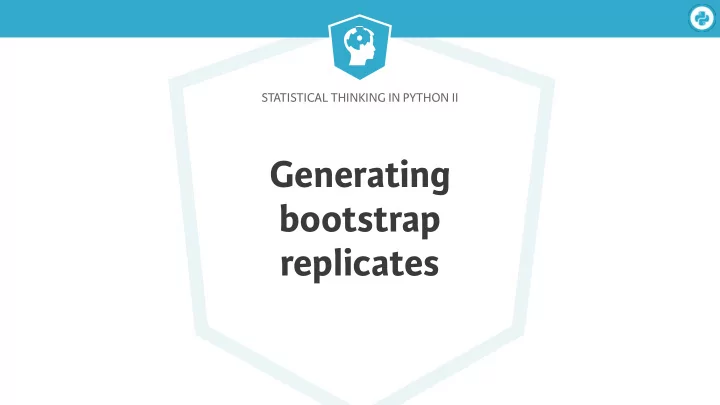

STATISTICAL THINKING IN PYTHON II Generating bootstrap replicates
Statistical Thinking in Python II Michelson's speed of light measurements Data: Michelson, 1880
Statistical Thinking in Python II Resampling an array Data: [23.3, 27.1, 24.3, 25.3, 26.0] Mean = 25.2 Resampled data: [ , , , , ]
Statistical Thinking in Python II Resampling an array Data: [23.3, , 24.3, 25.3, 26.0] Mean = 25.2 Resampled data: [27.1, , , , ]
Statistical Thinking in Python II Resampling an array Data: [23.3, 27.1, 24.3, 25.3, 26.0] Mean = 25.2 Resampled data: [27.1, , , , ]
Statistical Thinking in Python II Resampling an array Data: [23.3, 27.1, 24.3, 25.3, 26.0] Mean = 25.2 Resampled data: [27.1, 26.0, , , ]
Statistical Thinking in Python II Resampling an array Data: [23.3, 27.1, 24.3, 25.7, 26.0] Mean = 25.2 Resampled data: [27.1, 26.0, 23.3, 25.7, 23.3] Mean = 25.08
Statistical Thinking in Python II Mean of resampled Michelson measurements
Statistical Thinking in Python II Bootstrapping ● The use of resampled data to perform statistical inference
Statistical Thinking in Python II Bootstrap sample ● A resampled array of the data
Statistical Thinking in Python II Bootstrap replicate ● A statistic computed from a resampled array
Statistical Thinking in Python II Resampling engine: np.random.choice() In [1]: import numpy as np In [2]: np.random.choice([1,2,3,4,5], size=5) Out[2]: array([5, 3, 5, 5, 2])
Statistical Thinking in Python II Computing a bootstrap replicate In [1]: bs_sample = np.random.choice(michelson_speed_of_light, ...: size=100) In [2]: np.mean(bs_sample) Out[2]: 299847.79999999999 In [3]: np.median(bs_sample) Out[3]: 299845.0 In [4]: np.std(bs_sample) Out[4]: 83.564286025729331
STATISTICAL THINKING IN PYTHON II Let’s practice!
STATISTICAL THINKING WITH PYTHON II Bootstrap confidence intervals
Statistical Thinking in Python II Bootstrap replicate function In [1]: def bootstrap_replicate_1d(data, func): ...: """Generate bootstrap replicate of 1D data.""" ...: bs_sample = np.random.choice(data, len(data)) ...: return func(bs_sample) ...: In [2]: bootstrap_replicate_1d(michelson_speed_of_light, np.mean) Out[2]: 299859.20000000001 In [3]: bootstrap_replicate_1d(michelson_speed_of_light, np.mean) Out[3]: 299855.70000000001 In [4]: bootstrap_replicate_1d(michelson_speed_of_light, np.mean) Out[4]: 299850.29999999999
Statistical Thinking in Python II Many bootstrap replicates In [1]: bs_replicates = np.empty(10000) In [2]: for i in range(10000): ...: bs_replicates[i] = bootstrap_replicate_1d( ...: michelson_speed_of_light, np.mean) ...:
Statistical Thinking in Python II Plo � ing a histogram of bootstrap replicates In [1]: _ = plt.hist(bs_replicates, bins=30, normed=True) In [2]: _ = plt.xlabel('mean speed of light (km/s)') In [3]: _ = plt.ylabel('PDF') In [4]: plt.show()
Statistical Thinking in Python II Bootstrap estimate of the mean
Statistical Thinking in Python II Confidence interval of a statistic ● If we repeated measurements over and over again, p % of the observed values would lie within the p % confidence interval.
Statistical Thinking in Python II Bootstrap confidence interval In [1]: conf_int = np.percentile(bs_replicates, [2.5, 97.5]) Out[1]: array([ 299837., 299868.])
STATISTICAL THINKING WITH PYTHON II Let’s practice!
STATISTICAL THINKING IN PYTHON II Pairs bootstrap
Statistical Thinking in Python II Nonparametric inference ● Make no assumptions about the model or probability distribution underlying the data
Statistical Thinking in Python II 2008 US swing state election results Data retrieved from Data.gov (h � ps://www.data.gov/)
Statistical Thinking in Python II Pairs bootstrap for linear regression ● Resample data in pairs ● Compute slope and intercept from resampled data ● Each slope and intercept is a bootstrap replicate ● Compute confidence intervals from percentiles of bootstrap replicates
Statistical Thinking in Python II Generating a pairs bootstrap sample In [1]: np.arange(7) Out[1]: array([0, 1, 2, 3, 4, 5, 6]) In [1]: inds = np.arange(len(total_votes)) In [2]: bs_inds = np.random.choice(inds, len(inds)) In [3]: bs_total_votes = total_votes[bs_inds] In [4]: bs_dem_share = dem_share[bs_inds]
Statistical Thinking in Python II Computing a pairs bootstrap replicate In [1]: bs_slope, bs_intercept = np.polyfit(bs_total_votes, ...: bs_dem_share, 1) In [2]: bs_slope, bs_intercept Out[2]: (3.9053605692223672e-05, 40.387910131803025) In [3]: np.polyfit(total_votes, dem_share, 1) # fit of original Out[3]: array([ 4.03707170e-05, 4.01139120e+01])
Statistical Thinking in Python II 2008 US swing state election results Data retrieved from Data.gov (h � ps://www.data.gov/)
STATISTICAL THINKING IN PYTHON II Let’s practice!
Recommend
More recommend